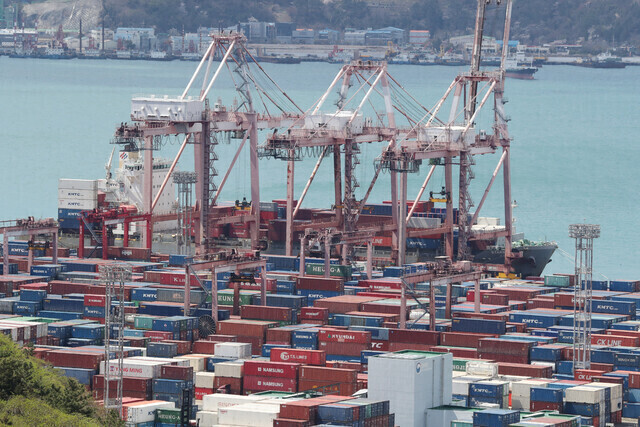hankyoreh
Links to other country sites 다른 나라 사이트 링크
Real economy indicators in S. Korea plunge amid financial market turbulence

Indicators related to South Korea’s real economy, including sentiment and outlook, are looking increasingly gloomy as a result of continuous financial market unrest. Concerns surrounding a major economic slowdown are growing in the wake of the so-called “three highs” of high inflation, high interest rates, and high exchange rates.
Following a professional survey index poll conducted from June 13-17 of 174 experts in each major industry, the Korea Institute for Industrial Economics and Trade announced Sunday that the manufacturing industry index in June was 76, down 15 points from May. That marked the second consecutive month of double-digit decline, with the extent of the decline also having grown. This is the lowest figure since May 2020.
The manufacturing outlook for July fell even more sharply, forecasted at only 77 — 17 points lower than this month (94) and the lowest level in more than two years.
An index above 100 means that companies believe the situation will improve or has improved compared to the previous month. Any figure below 100, however, indicates the opposite — pessimism about the present and future economic situation.
Looking at the June industry index by sector, both domestic demand (76) and exports (80) fell by 19 points each. Meanwhile, production (86) decreased by 15 points, investment amount (92) decreased by 9 points, and profitability (69) decreased by 14 points. By industry, with the exception of shipbuilding, the semiconductor, automobile, machinery, and steel industries mostly fell below their original baseline figures.
Above all, the outlook for exports, which had been positive, is now getting worse. The export business survey index for the third quarter of this year announced by the Korea International Trade Association (KITA) on Sunday was 94.4, which was lower than in the second quarter (96.1).
This is the first time since the second quarter of 2020 that the index has fallen below the baseline figure of 100. The index surveyed 1,301 domestic exporting companies from May 30 to June 10. A reading below 100 means that a larger share of companies expect the export economy to deteriorate compared to the previous quarter.
By item, exports of 11 items, including automobiles (parts), plastics, rubber, steel, and non-ferrous metals, are expected to decline compared to the previous quarter. On the other hand, the shipbuilding, semiconductors, and chemical industries are expected to grow their exports in the third quarter.
Exporting companies cited higher raw material prices (84.9%) and higher logistical costs (74.4%) as risk factors for exports in the third quarter. A big jump was also recorded in those citing increased exchange rate volatility (32.7%) as a major concern compared to the previous quarter (22.5%).
According to KITA’s analysis, unlike in the past, the burden of rising imported raw material prices is greater than the factors that increase price competitiveness due to higher exchange rates.
Kim Min-woo, a senior researcher at KITA, predicted that “the uncertainty of the export environment will increase further due to global inflation and accelerated interest rate hikes.”
By Kim Hoe-seung, senior staff writer
Please direct questions or comments to [english@hani.co.kr]

Editorial・opinion
![[Guest essay] Maybe Korea’s rapid population decline is an opportunity, not a crisis [Guest essay] Maybe Korea’s rapid population decline is an opportunity, not a crisis](https://flexible.img.hani.co.kr/flexible/normal/500/300/imgdb/original/2024/0430/9417144634983596.jpg) [Guest essay] Maybe Korea’s rapid population decline is an opportunity, not a crisis
[Guest essay] Maybe Korea’s rapid population decline is an opportunity, not a crisis![[Column] Can Yoon steer diplomacy with Russia, China back on track? [Column] Can Yoon steer diplomacy with Russia, China back on track?](https://flexible.img.hani.co.kr/flexible/normal/500/300/imgdb/original/2024/0430/1617144616798244.jpg) [Column] Can Yoon steer diplomacy with Russia, China back on track?
[Column] Can Yoon steer diplomacy with Russia, China back on track?- [Column] Season 2 of special prosecutor probe may be coming to Korea soon
- [Column] Park Geun-hye déjà vu in Yoon Suk-yeol
- [Editorial] New weight of N. Korea’s nuclear threats makes dialogue all the more urgent
- [Guest essay] The real reason Korea’s new right wants to dub Rhee a founding father
- [Column] ‘Choson’: Is it time we start referring to N. Korea in its own terms?
- [Editorial] Japan’s rewriting of history with Korea has gone too far
- [Column] The president’s questionable capacity for dialogue
- [Column] Are chaebol firms just pizza pies for families to divvy up as they please?
Most viewed articles
- 1Under conservative chief, Korea’s TRC brands teenage wartime massacre victims as traitors
- 2Months and months of overdue wages are pushing migrant workers in Korea into debt
- 3[Guest essay] Maybe Korea’s rapid population decline is an opportunity, not a crisis
- 4[Column] Can Yoon steer diplomacy with Russia, China back on track?
- 5After election rout, Yoon’s left with 3 choices for dealing with the opposition
- 6First meeting between Yoon, Lee in 2 years ends without compromise or agreement
- 7[Column] Behind factional animus of Korean politics, victim mentality festers
- 8‘We must say no’: Seoul defense chief on Korean, USFK involvement in hypothetical Taiwan crisis
- 9[Editorial] Japan’s removal of forced labor memorial tramples on remembrance, reflection and friends
- 10[Guest essay] A society in which old age becomes a burden